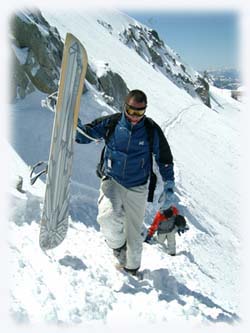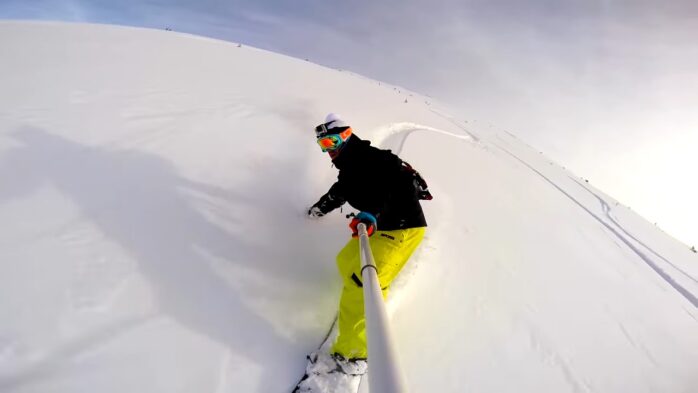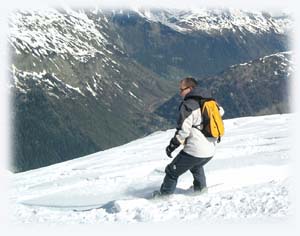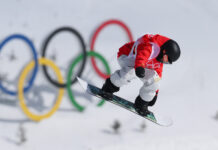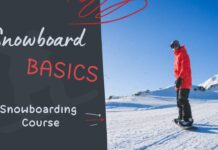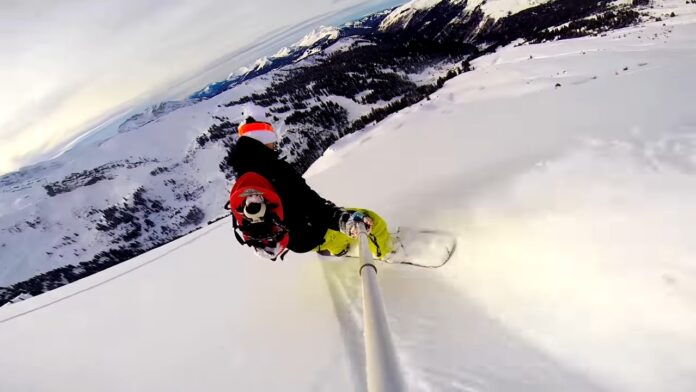
As you might have read in our Snowboarding History section, the first snowboarders were not allowed to go Snowboarding On Piste. So the entire sport actually started Off Piste. At present, a lot of people still prefer snowboarding Off Piste – Backcountry Snowboarding.
Backcountry Snowboarding is for more advanced Snowboarders. Consequently, you will need to have a lot more knowledge and (other) skills before you leave the safe environment that Snow Resorts create. This section introduces you to Off Piste and Backcountry Snowboarding.
Advanced Skills
If you learned to Snowboard on well groomed pistes in nice snow resorts then you are in for a surprise when you go Off Piste.
- Snow & Surface Conditions
You will need a high skill level on all kinds of surface. From the Hardest Ice to the Softest Powder Snow Surface, you need to be able to maintain total control of your board. - Avoiding Obstacles
In snow resorts you might have been confronted with the occasional tree along the piste. Off Piste you will have to have enough board control to avoid crashes with trees and boulders or falls off cliffs or crevasses. You will need to have enough turning power to avoid these obstacles last minute. - Mountain & Rescue Skills
Avalanche Awareness, First Aid in Snowboarding and basic Mountaineering skills are essential for Backcountry Snowboarding. Make sure to learn them either through books or preferably through licensed instructors.
We have an introduction to Snowboarding Safety Skills.
Make sure you are able to assess possible dangerous situations and deal with them wisely. Hundreds of people injure themselves each year in Backcountry Snowboarding, and most of the accidents could have been avoided.
Gear & Preparations
As explained above you will need to increase your knowledge and skills before you can take off into the wild. Check the following:
Your Snowboard
If you are going to cruise through soft and deep powder you might want to take a larger board and adjust your stance by moving your bindings slightly to the Tail of the Snowboard.
By having a larger board and putting more weight on the tail side of the board, it will be easier for you to keep your board floating above the powder instead of digging itself in. You do not want to get stuck in chest deep powder in the Backcountry! If you are a real Backcountry enthusiast then you could consider getting a special Swallowtail Backcountry Board.
Gear & Supplies
Pack the following basics:
- First Aid Kit – in case of accidents
- Food – for nutrition
- Hydration Packs – for easy water access
- Extra Snowboarding Clothing – in case of colder weather
- Detailed Map of the Snowboard or Ski Resort – for knowing your where abouts
- A compass or GPS – for coordination
- Mobile Phone – for contacting people
- Sunblock – for protection from the sun
- Snowboard Goggles – for protection from the sun, snow, ice and branches
- Snowboard Helmet – for head protection
- Emergency Whistle – for calling attention
- Avalanche Transceivers – for telling your where abouts in an avalanche
- Snow Shovels – for digging yourself out of the snow
Bring the following equipment depending on the route you are taking and the terrain you will encounter:
- Trekking Poles – for trekking difficult terrain
- Snow Shoes – for crossing deep snow
- Belays and Harnasses – for climbing
- Ropes – for crevasse rescue and rock-/ice climbing
- Crampons – for icy surfaces and ice climbing
- Ice Axes – for icy surfaces and ice climbing
Getting into it
There is no simple way to learn Backcountry Snowboarding. You will need to push your own limits until you are confident enough to really go for it. The following list could be a good road map to set you up for Backcountry Snowboarding:
- Make sure that your standard snowboarding techniques are well developed and you posses the skills described above.
- Once you are ready for it, give small Off Piste runs a try in your snow resort. Make runs through the trees and practice your last moment turning skills. Do not make these runs alone. Take a friend who can help you in the worst case.
- Work on your basic Mountain & Survival Skills & Knowledge as described above.
- Try the unmarked/ungroomed backcountry routes that some larger Ski Resorts offer. Make sure to plan these runs ahead and know the route you are going take. Try making them with someone who knows the area and is more experienced. Take the backcountry gear with you as described above.
- Once you are at a comfortable with backcountry routes you can really start planning your own routes. From this point on the sky is the limit! You could hike/climb up and board down, book runs with snowcat transport or head for the skies with a helicopter. At this moment Heli-Boarding is pretty much the limit when it comes to Backcountry Snowboarding…

